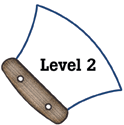|
National Science Education Standards
Develop descriptions, explanations, predictions, and models using evidence.
Students should base their explanations on what they observed and as they
develop cognitive skills, they should be able to differentiate explanation
from description—providing causes for effects and establishing relationships
based on evidence and logical argument. (Page 145)
Materials can exist in different states—solid, liquid, and gas.
Some common materials, such as water, can be changed from one state to
another by heating and cooling. (Page 127)
Earth materials are solid rocks and soils, water, and the gases of the
atmosphere. The varied materials have different physical and chemical
properties, which make them useful in different ways, for example, as
building materials, as sources of fuel, or for growing the plants we use
as food. Earth materials provide many of the resources that humans use.
(Page 134)
Soils have properties of color and texture, capacity to retain water,
and ability to support the growth of many kinds of plants, including those
in our food supply. (Page 134)
|
|
Benchmarks
Seeing how a model works after changes are made to it may suggest how
the real thing would work if the same were done to it. (Page 268)
No matter how parts of an object are assembled, the weight of the whole
object made is always the same as the sum of the parts; and when a thing
is broken into parts, the parts have the same total weight as the original
thing. (Page 77)
Materials may be composed of parts that are too small to be seen without
magnification. (Page 77)
|


